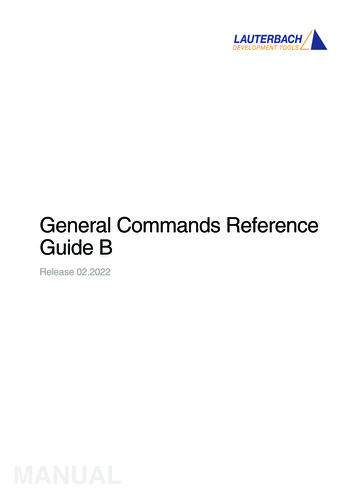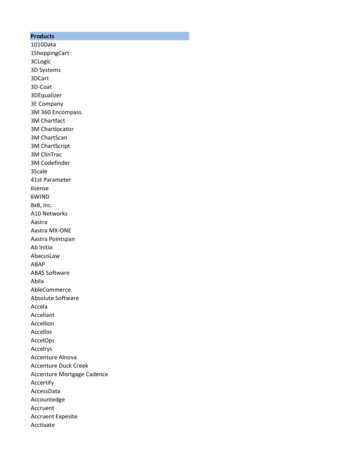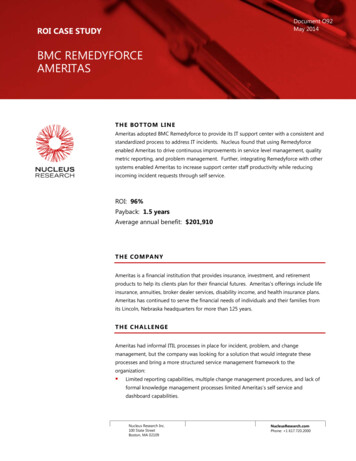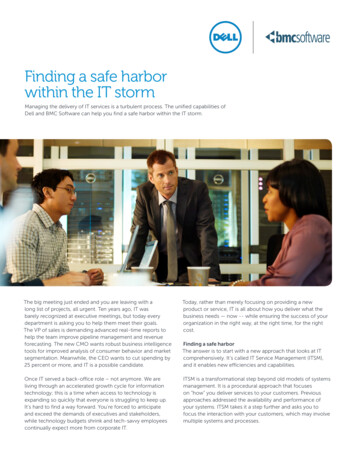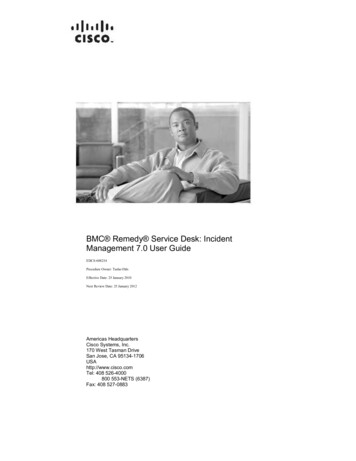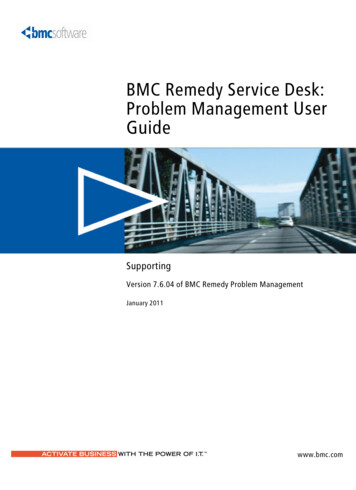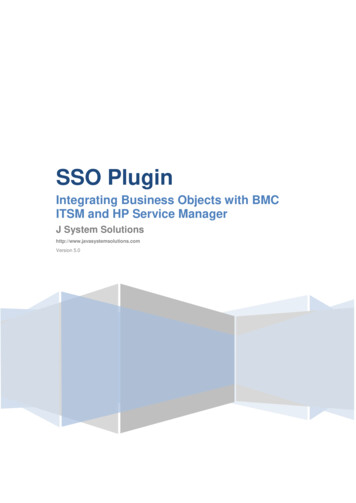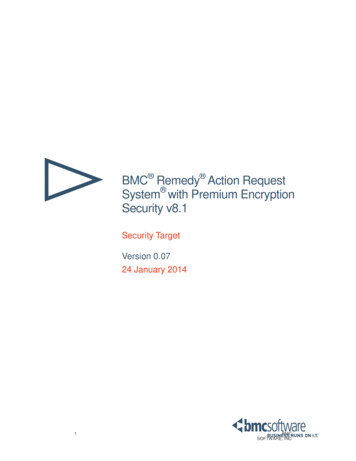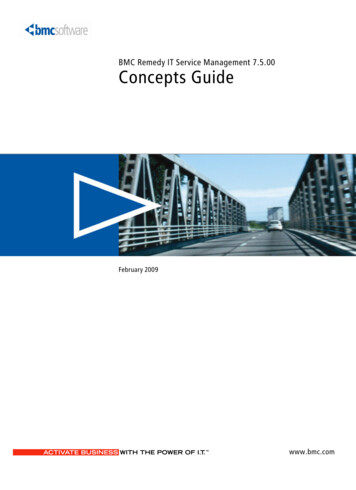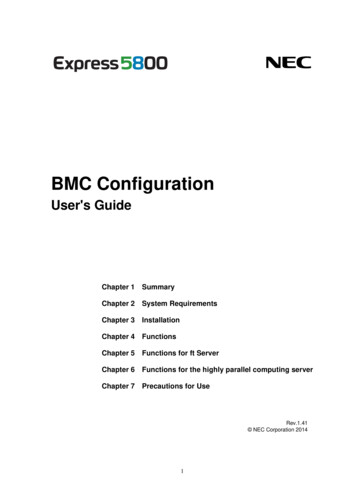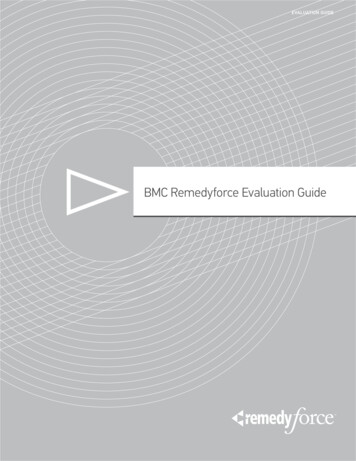
Transcription
EVALUATION GUIDEBMC Remedyforce Evaluation Guide
TABLE OF CONTENTSPART 1: THE ALIGNABILITY PROCESS MODEL . . . . . . . . . . . . . . . . . . . . . . . . . . . . . . . . 1PART 2: EVALUATING BMC REMEDYFORCE REPORTING . . . . . . . . . . . . . . . . . . . . . . . . . . . 8PART 3: EVALUATING THE BMC REMEDYFORCE SELF-SERVICE PORTAL . . . . . . . . . . . . . . . 15PART 4: EVALUATING THE BMC REMEDYFORCE SERVICE DESK AGENT DASHBOARDS . . . . . . . 21PART 5: EVALUATING BMC REMEDYFORCE INCIDENT MANAGEMENT . . . . . . . . . . . . . . . . . 27PART 6: EVALUATING BMC REMEDYFORCE PROBLEM MANAGEMENT . . . . . . . . . . . . . . . . . 34PART 7: EVALUATING BMC REMEDYFORCE CHANGE MANAGEMENT . . . . . . . . . . . . . . . . . . 40PART 8: EVALUATING BMC REMEDYFORCE CHATTER INTEGRATION . . . . . . . . . . . . . . . . . . 46
Evaluating the BMC Remedyforce Alignability Process ModelINTRODUCING THE ALIGNABILITY PROCESS MODELYour end users are more demanding than ever. They want immediate attention andimmediate results — or in IT terms — fast response times and instant problemresolution. They also demand consistently high levels of service, and of course, theyexpect constant communication on the status of their requests. How do you meet suchdemands when your own IT resources may be under significant strain?Many organizations around the world have turned to the best practices recommendedby ITIL as a way to cut costs, align resources, improve service levels, and deliverconsistent levels of service to the business.YOU WILL NEED:10 MINUTESAs you evaluate IT help desk software, make sure that the application will enable youto take advantage of the best practices recommended by ITIL — without requiring toomuch additional configuration from you. It’s also a good idea to check that the bestpractices are documented and that the documentation is easily accessible by users.BMC Remedyforce includes ITIL best-practice workflows built right into the software.Plus, it comes with extensive online documentation of the process models. With the helpof embedded best practices, you can achieve faster cost savings and improvements inservice quality that can benefit your entire organization.WATCH THE VIDEO NOWWHAT YOU’LL SEE IN THE REMEDYFORCE TRIALAlthough you can explore the Remedyforce trial on your own, we recommend that youfollow the steps outlined in each scenario. This guided tour can help you make the mostof the software, including the specific features related to ITIL best practices. In thisscenario you will:»» Access Remedyforce from the perspective of a service desk agent.»» Learn about the embedded ITIL best practices for incident, problem, and changemanagement»» Review the process flow documentation for each of the best practices.To see the scenario in action, watch the video here.1
LET’S GET STARTED.First, locate the Welcome email you received after registering for the BMC Remedyforce trial. This email includesa link for launching the trial. If you have not yet registered for the trial, register here and the email will be sentto you.1. Use the link in your Welcome email to launch the Remedyforce trial. Note the user nameand password for IT staff; then, click “Login as IT staff.”2. You should now see the BMC Remedyforce home page. Note the “Workspaces” panel onthe lefthand side of the screen — this is where we will begin exploring the ITIL best practicesfor incident, problem, and change management.2
3. Review the Incident Management process.»» Click on the “Workspaces” panel on the left hand side of the screen»» Then under “Incident Management,” click on “Incident Management Alignability Process Model.”You’re now looking at a visualrepresentation of the IncidentManagement process — one ofthe Alignability Process Modelsin BMC Remedyforce.3
»» Interact with the process model to get more information about each step. For example, click on “1. SupportRequest Registration.”(Tip: To see more information, you can also mouse-over the flowchart and the description.)»» You should now see the Support Request Registration procedure for a service desk analyst.Note that you can refer to the Incident Management process model at any time to review the ITIL guidelines forany incident management task.
4. Review the Problem Management process.»» In the “Workspaces” panel, under “Problem Management,” clickon “Problem ManagementAlignability Process Model.”Click on “1. Support Request Review.” You should now see theSupport Request Review process for a problem coordinator.Notice how easy it is to switchbetween process models?We’ve designed the BMCRemedyforce interface to besimple to use in a busy ServiceDesk environment.5. Review the Change Management process.»» Under “Change Management,” click on “Change ManagementAlignability Process Model.”Click on “1. Change Registration.” You should now see the Change Registration process for a changecoordinator.5
»» Feel free to review the rest of the process model on your own. When finished, click the “X” to close theAlignability Process Model tab. This concludes this part of the evaluation.THE METRICS THAT MATTERThere are literally hundreds of metrics and key performance indicators referenced by ITIL and similarbest practice frameworks — some may be very relevant in your organization, while others may be lessuseful. However, the following metrics can really tell you whether ITIL best practices are paying off for yourorganization.MEAN TIME TO RESOLUTION (MTTR)MTTR is a critical metric that records the total time taken from the reporting of an issue, through its finalresolution. It’s important because it reflects the robustness and efficiency of the processes and systems youhave in place for supporting your users. Adopting ITIL best practices for incident and problem management, inparticular, can have a dramatic effect on MTTR.»» What you should aim for: 20% lower MTTR.STAFF PRODUCTIVITYThe productivity of your service support teams should improve as a direct result of aligning your processes toITIL best practices. Greater consistency in how problems are investigated and resolved can result in significanttime savings across the organization. In addition, ongoing discipline in change management can improve theoverall stability of your IT infrastructure.»» What you should aim for: 30% higher staff productivity.
SERVICE DESK COSTSIn addition to the time savings and gains in productivity, many organizations can reduce the cost of theirservice desk operations by aligning with ITIL best practices. Improved communication, effective self-servicecapabilities, and reduced incident volumes are all outcomes of ITIL best practices, and they can directlycontribute to lower operating costs for the IT service desk.»» What you should aim for: 25% lower IT help desk costs.WHAT THE EXPERTS SAY:Remedyforce will increase IT resource availability and customer sat““Cloud-basedisfaction at lower cost — at a time when cutting costs without sacrificing quality isa top priority.”Eduardo Don Jr.CEO Lumen21WANT TO KNOW MORE?Learn more about the benefits of ITIL best practices. Read our Solutions page.Get the details on ITIL processes. Check out our reference library.WHAT TO DO NEXT NEED TO GET IN TOUCH?Call us at 1-855-834-7487 or email us.READY TO BUY?Purchase BMC Remedyforce now.7
Evaluating BMC Remedyforce ReportingINTRODUCING BMC REMEDYFORCE REPORTINGEffective reporting capabilities are an essential component of any IT service managementapplication. Well-designed reports can provide real insight into the effectiveness of yoursupport teams, your IT infrastructure, and the processes you have in place. Help deskorganizations that are disciplined in the collection and analysis of reports consistently offerbetter service and tend to enjoy greater systems stability — as a result of acting upon theperformance trends identified in the data.YOU WILL NEED:10 MINUTESAs you evaluate IT help desk systems, make sure that the software has more than justa wide range of reports — consider the relevance of those reports for your organizationand how easily they can be adapted to meet your needs. Every IT help desk environment isdifferent, so flexibility is essential. Ideally, the software should also allow you to create andconfigure custom reports.BMC Remedyforce offers a number of pre-defined reports, which have evolved fromrecognized best practices and the feedback of our customers. Each report can also beextensively customized to meet your needs and saved for future use.WATCH THE VIDEO NOWBMC Remedyforce exploits the considerable reporting power of the underlying Force.comSaaS platform. This means you can create and adapt brand-new custom reports to meetalmost any requirement imaginable.WHAT YOU’LL SEE IN THE REMEDYFORCE TRIALThis part of the Remedyforce trial shows you how easy it is to use and adapt one of themany pre-defined reports that come with the software. You’ll also get to walk through theprocess of exporting data to an external file.To see the scenario in action, watch the video here.8
LET’S GET STARTED.First, locate the Welcome email you received after registering for the BMC Remedyforce trial. This email includesa link for launching the trial. If you have not yet registered for the trial, register here and the email will be sentto you.1. Use the link in your Welcome email to launch the Remedyforce trial. Then, enter yourname and password to log into the site.9
2. You should now see the BMC Remedyforce home page.3. Run an Incident Management report.»» Click on the “Setup” link on the upper righthand corner of the BMC Remedyforce home page.In the dialog box asking if you want to leave BMC Remedyforce, click “Yes.” This will take you into the reportingand configuration portal of the force.com platform.10
»» Click on the “Reports” link in the menu bar.»» In the “Reports Folders” section, click on the “Folder” dropdownmenu and select “BMC Remedyforce.” Then, click “Go.”You can view and configure outof-the-box reports or you cancreate custom reports to meetyour organization’s exact needs.»» Click on the “Categories” link at the top of the list. You’ll see achart, and above that, some options.»» In the “Report Options” section, click on the “Summarizeinformation by” dropdown menu and select “Category.” (Note: Itmay already appear at the top of the list.)Remedyforce includes a numberof pre-configured reports thatsupport ITIL best practices,standard compliance goals, andthe most common needs of ourcustomers.»» Next, click on the “Show” dropdown menu, select “All Incidents”and click “Run Report.”»» You should now see a chart that summarizes the incident volumes by category, followed by a detailed list ofthe incidents included in the report.Notice that you can save thisreport, as well as customize,print, or export it to a numberof different formats.Exporting a report is what we’llexplore next.(Tip: Scroll down to see more of the report content.)11
4. Export a report.»» In the “Report Options” section of the “Categories” page, click on the “Export Details” button.»» In the “Export Report” section, choose your file encoding and format preferences. Then, click “Export.”»» In the dialog box that appears, click to save and open the file.»» Review the exported file. When finished, click the “Done” button to return to the “Categories” page.5. Customize a report.12
»» In the “Report Options” section of the “Categories” page, click on the “Customize” button.»» Click on the “Jump to Step” menu.»» Without changing anything for now, click on each option in the “Jump to Step” menu and simply review all theways that you can customize the standard reports.»» Ok, let’s try a simple customization. From the “Jump to Step” menu, select “Select Columns” and click on “clientemail” (and anything else you’d like to see) in the left column of checkboxes.»» Click on the “Run Report” button at the bottom left of the options table to view your custom report. Whenfinished, click the “BMC Remedyforce Home” link to close the reporting portal and return to the application.This concludes Part 2 of the Remedyforce evaluation.THE METRICS THAT MATTEREffective reporting capabilities can positively impact the performance and efficiency of your help deskorganization in many different ways — particularly when the actionable data is rolled into your ongoingimprovement initiatives.The following Key Performance Indicators (KPIs) can help you assess the effectiveness of your reportingstrategies.CHANGE SUCCESS RATEA change management process that is flawed and is causing unnecessary service disruption often shows up inreporting long before a specific weakness in the process is identified by other means. In our experience, a teamthat is actively reviewing reports — especially the reports of incident volumes resulting from changes — willquickly spot areas for investigation and improvement. This often has an immediate and beneficial impact on thesuccess rate of the changes undertaken.»» What you should aim for: 90% or greater first-time change success rates.RECURRENT INCIDENT VOLUMEHelp desk reports are a highly effective means of analyzing patterns in the flow and types of IT incidents that areoccurring in your organization. Regular analysis of incident category reports, for example, can reveal specific andfrequently recurrent areas of difficulty in the infrastructure and support processes (and sometimes, individuals).Organizations that are disciplined in this analysis, and take action accordingly, tend to have fewer recurrentproblems and see a more even spread of root causes.»» What you should aim for: Where possible* 10% or less of your incidents should relate to any one specificcategory.*In some environments there will always be a bias to specific problem areas.13
COMPLIANCE COSTFor those help desk organizations subject to regulatory or corporate compliance reporting, the time and efforttaken to respond to a specific audit request is a very reliable health indicator of your reporting model. If you havecorrectly identified and configured the set of reports you need to meet compliance requirements, the process ofproviding the necessary data in an acceptable format should be rapid and uncomplicated.»» What you should aim for: Less than 24-hour responses to an audit request.WHAT THE EXPERTS SAY:the past, we didn’t have tools that enabled us to do the best job possible.“““InSometimesissues fell through the cracks, which meant that our users were notalways completely happy with our service. With BMC Remedyforce, IT staff members have a solution that lets them deliver high-quality service and support. As aresult, our users are happier with what IT is doing for them.”can determine if the same problem occurred before or if we’re having mul“““Wetiple problems with a particular asset or asset type.”Can Ersoz,Manager of Information Systems at YakultWANT TO KNOW MORE?Learn more about ITIL continual service improvement. Read the e-book.Get expert advice on supporting compliance goals. Sign up for the e-book.WHAT TO DO NEXT NEED TO GET IN TOUCH?Call us at 1-855-834-7487 or email us.READY TO BUY?Purchase BMC Remedyforce now.14
Evaluating the BMC Remedyforce Self-Service PortalINTRODUCING THE SELF-SERVICE PORTALWhy do effective IT organizations offer self-service features for their users? It’s simple,really — a self-service portal can deliver measurable gains in efficiency and productivity.If users can easily get updates about ongoing issues, find solutions to their problems, andrequest service in a simple but structured way, they are less likely to consume precioushelp desk resources.YOU WILL NEED:10 MINUTESAs you evaluate your choice of an IT help desk vendor, self-service should be an importantarea of consideration. Some key questions include: Are the self-service options accessiblefrom a variety of devices? Are they easy to use? How effective is the presentation andorganization of self-service information? The easier the system is to use, the greater thechance the resources will be used throughout your organization.BMC Remedyforce provides a simple and well-organized self-service portal — users canreview current issues affecting the organization, see the most common problems theircolleagues are facing, and check out the associated solutions. Users can also request helpfrom the help desk using out-of-the-box templates, which can help save time and ensuregreater consistency in how requests are submitted.WATCH THE VIDEO NOWWHAT YOU’LL SEE IN THE REMEDYFORCE TRIALThe Remedyforce trial environment is perfect for evaluating the self-service portal on yourown. However, this specific scenario can also help you:»» Explore the self-service portal interface.»» Search and rate knowledge entries.»» Request multiple services from the help desk.To see the scenario in action, watch the video here.15
LET’S GET STARTED.First, locate the Welcome email you received after registering for the BMC Remedyforce trial. This email includesa link for launching the trial. If you have not yet registered for the trial, register here and the email will be sentto you.1. Use the link in your Welcome email to launch the Remedyforce trial. Note the user nameand password for the end user; then, click “Login as end user.”2. You should now see the BMC Remedyforce log-in page. Enter the user name and password for the end user, as shown above. Then, click “Login.”3. The Self-Service Portal should appear. We will explore this interface in the next severalsteps.16
4. Review the Self-Service home page.»» Take a look at the areas highlighted on the portal page below.(Tip: To see the full text without opening an item, you can mouse-over the different components.)Search for solutionsto problems.View the frequently askedquestions and responsesfrom the Knowledge Base.Check for important updates in the scrolling barand the “Broadcasts” section. This can save youthe time of creating tickets about known issues.The most popular service requests arelisted here. A great deal of time can besaved by using these templates.Any service requests youcreate will appear here.5. Access and rate a Knowledge Base entry.»» In the “Frequently Asked Questions” section of the portal, click on the entry “How do I reset my Blackberry?”The entry will open in the Knowledge Base screen.Notice that there are a number of actions you can take from here. You can:»» Read and then rate the Knowledge Base entry — this impacts its relevance in future searches and improvesthe accuracy of the Knowledge Base.»» Search externally online using the same search terms.»» View other related Knowledge Base entries by navigating the knowledge tree.»» Create a Service Request if you need assistance from the help desk.»» Click on “Self Service Home” to continue with the evaluation.17
6. Create Service Requests.Let’s assume that you’ve been locked out of your user account, due to multiple log-in failures.»» In the “Top Service Requests” section of the portal, click on the “Password Reset” entry.»» In the “Describe What You Need” dialog box, enter “Sally Smith” for the account name and “Ssmi” for theaccount ID. Then, click “Submit.”»» Click on “Self Service Home” to continue with the evaluation.Next, let’s imagine that your external hard drive fails too.»» In the “What Do You Need Help With?” section, type in the “Search” field: “My hard disk has crashed.” Then,click on the “Find Solution” button.»» It looks like there’s nothing in the Knowledge Base for this particular problem. Let’s get some help.»» Click on the “Submit a New Service Request” link.»» In the “Category” dropdown menu, select “Hardware.”»» In the “Describe What You Need” field, type: “My hard disk crashed. I need a replacement and to have any datatransferred.” Then, click “Submit.”To help the support teams, you can find the online warranty link and add it to the service request.»» Open the service request you just created.»» In the “Documentation” section of the service request, click the “Add” button.»» Next, click the “URL” radio button.»» Type the URL: icy/en/policy?c us&l en&s gen& section 010»» Click “OK.” Then, click “Submit.”»» On the navigation bar, click on “Self Service Home.” This concludes Part 3 of the Remedyforce evaluation.18
THE METRICS THAT MATTERHow do you assess the relative effectiveness of your self-service strategy? There are many parameters thatcan be analyzed. However, by focusing on key performance indicators that capture the uptake, cost, and impactof self-service, you can be sure that you have a well-balanced appraisal that will facilitate corrective action orprompt further investigation. The following three metrics can be particularly revealing.PHONE CALL DEFLECTION RATEOrganizations that have implemented self-service often report a significant drop in the number of calls to theservice desk. Phone-based interactions represent some of the highest costs per incident, and anything thatcan free up an agent from the phone yields great returns. When help desk services are provided promptly andappropriately via self-service, its adoption tends to build significantly over time.»» What you should aim for: 50% of incidents and service requests processed through self-service.COST PER INCIDENTSelf-service help desk interactions cost organizations a fraction of those initiated via the phone or in person.The savings largely results from the removal of a first-line agent from the earlier phases of incident reportingand classification — which, in turn, reduces the amount of time that agent spends investigating and resolving anincident.»» What you should aim for: A 25% reduction in the cost of providing help desk services.MEAN TIME TO RESOLUTION (MTTR)When users can quickly and easily categorize and record the challenge they’re having, or in many cases, takeself-initiated corrective action, you can dramatically reduce the time needed to resolve issues. The secret tohaving a measurable impact on MTTR is to develop an effective Knowledge Base that’s delivered via your selfservice portal. In addition, you need to make sure that it’s easy to create service requests in a structured waythat maximizes consistency and minimizes error.»» What you should aim for: A 20% reduction in MTTR.19
WHAT THE EXPERTS SAY:Remedyforce will save us approximately 25 percent the first year, and will cut“““BMCour costs nearly in half in years two and three.”Can Ersoz,Manager of Information Systems at YakultWANT TO KNOW MORE?Learn more about empowering users with self-service. Get the white paper.Get the ITIL perspective on providing self-service. Read the e-book.WHAT TO DO NEXT NEED TO GET IN TOUCH?Call us at 1-855-834-7487 or email us.READY TO BUY?Purchase BMC Remedyforce now.20
Evaluating the BMC Remedyforce Service Desk Agent DashboardsINTRODUCING THE SERVICE DESK AGENT DASHBOARDSInformation design and accessibility is a critical discipline in the optimization of an IT helpdesk application. Apart from the obvious benefits of an interface that’s easy to use, readyaccess to critical information about support activity and associated trends has a direct andmaterial impact on the effectiveness of your help desk. With a properly configured interface,agents spend less time and effort detecting patterns of failure, investigating problems, andcommunicating the actionable results of their work.YOU WILL NEED:15 MINUTESWATCH THE VIDEO NOWIn your efforts to compare IT help desk systems, be sure to consider how informationis presented in the principal interface for agents. It won’t be absolutely perfect for yourorganization, by default, so focus on how easy it will be to customize the interface overtime. Make sure that the solution doesn’t just facilitate the clear display of critical data —investigate whether it’s equally straightforward to broadcast critical updates. You shouldalso be able to correlate summary information to the underlying incidents, problems, andchanges.BMC Remedyforce is designed to clearly and effectively display information within a highlyconfigurable agent dashboard. Information can be conveyed in a variety of formats, anddashboards can be customized for the tasks at hand. It’s very easy to publish and monitorbroadcasts — and at any time — you can access the underlying details for the informationdisplayed in the dashboard.WHAT YOU’LL SEE IN THE REMEDYFORCE TRIALFeel free to explore the Remedyforce dashboards on your own in the trial environment —this scenario only scratches the surface of what’s possible. In this scenario you will:»» Review the basic components of the Remedyforce dashboard.»» Learn about the power and flexibility of the broadcast system.»» Find out how to customize the content and layout of the dashboard.To see the scenario in action, watch the video here.21
LET’S GET STARTED.First, locate the Welcome email you received after registering for the BMC Remedyforce trial. This email includesa link for launching the trial. If you have not yet registered for the trial, register here and the email will be sentto you.1. Use the link in your Welcome email to launch the Remedyforce trial. Note the user nameand password for IT staff; then, click “Login as IT staff.”2. You should now see the BMC Remedyforce log-in page. Enter the user name and password for IT staff, as shown above. Then, click “Login.”3. The agent portal should appear. We will explore this interface in the next several steps.22
4. Review the agent portal.»» Take a look at the areas highlighted on the portal page below(Tip: To see the full text without opening an item, you can mouse-over the different components.)In the “Workspaces” panel, youcan review the best-practiceprocess documentation andflowchartsAs a service desk administrator, you can bothview and edit broadcast entries. The broadcastscan be seen both as a scrolling banner and in the“Broadcasts” section. This can help prevent ticketsfrom being created about known issues.Here you can see all currentincidents ordered by priority.Everything on this “MyDashboard” panel can beconfigured and re-arranged tosuit your needs.This section can display allincidents currently assignedto you.23
5. Review a broadcast entry.»» Mouse-over the “Broadcasts” section on the righthand side of the agent portal.»» Double-click on “www.calbro.net is DOWN.”»» Note that broadcasts are highly configurable. You can adjust the timing, ownership, and display preferences— and even select which groups can see the broadcast. In addition, you can add more detail and a resolution,when one exists. This means users and other help desk agents can take corrective action and reduce the netimpact of a given problem.»» Scroll down to the bottom of the page and click “Show Supporting Information.”»» In the lefthand column, click on “Incidents.”»» Note that any incidents related to this broadcast can be reviewed and accessed here; this capability is a greatboost to agent productivity and can aid in problem investigation.»» Click on the “X” to close the Broadcasts panel.24
6. Personalize the dashboard.»» From the agent portal, click on the “My Dashboard” tab.»» Find the “Incidents by Category” section, and click on the “X” to remove the section.»» Click on the “Catalog” panel on the lefthand side of the screen.»» Click and hold down the mouse on “My Tasks.” Then, drag and drop it onto the dashboard area of the portal.Now you can see the specific tasks assigned to you.»» This concludes Part 4 of the Remedyforce evaluation.THE METRICS THAT MATTERThe presentation and configuration of information in an agent’s dashboard can have a direct impact on his/her productivity and effectiveness. Agents who can readily access and communicate information about currentincidents, problems, and changes will spend less time in the initial phases of investigation — and often, they willavoid creating new incidents altogether. The information they broadcast can also stop end users from reportinga known problem — further boosting the efficiency of the entire help desk team.To assess the effectiveness of your agents’ help desk interface, as well as the information contained within it,consider the following key performance metrics. As always, metrics can be affected by isolated incidents, butmeasuring the overall trends — particularly after customizing the agent interface — can be revealing.AVERAGE FIRST-CALL RESOLUTION RATEThe rate at which agents can resolve incidents on the first call can be directly impacted by the effectivepresentation of information. In particular, easy access to current ongoing support activities, such as recentproblems and changes, can lead an agent to a satisfactory resolution without further investigation.»» What you should aim for: A 25% increase in first-call resolution over time, along with upticks in average agentperformance.25
MEAN TIME TO RESOLUTION (MTTR)The time it takes to resolve an issue can also be affected by the availability and format of information. Often, anissue that’s under investigation will be affecting other users and show up in other incidents reported to the helpdesk team. Agents who can see the pattern of incidents currently under management — as well as monitorbroadcasts — are able to resolve incidents with greater speed.»» What you should aim for: An optimized agent interface could yield a 20% reduction in MTTR.STAFF PRODUCTIVITYThe net effect of a lower MTTR and higher first-call resolution rate is an overall increase in the productivity ofyour help desk agents. With their primary interface to the help desk system fully optimized and aligned with theirresponsibilities, help desk agents can resolve and manage a higher volume of activity.»» What you should aim for: Again, an optimized interface can result in a net increase of 20% in s
5 4. Review the Problem Management process. » In the "Workspaces" panel, under "Problem Management," click on "Problem Management Alignability Process Model." Click on "1. Support Request Review." You should now see the
